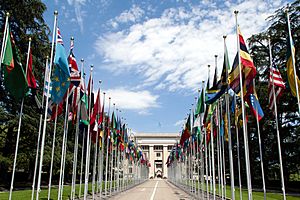United Nations resolution facts for kids
A United Nations resolution (or UN resolution) is a formal written decision made by a part of the United Nations (UN). While many UN groups can make resolutions, most of them come from two main bodies: the Security Council and the General Assembly. These are known as Security Council resolutions and General Assembly resolutions.

Contents
What is a UN Resolution?
A UN resolution is like a formal statement or decision that the United Nations makes. It's a way for the UN to express its views, make recommendations, or decide on actions regarding global issues.
Are UN Resolutions Law?
This is a good question! It depends on which UN group makes the resolution.
General Assembly Resolutions
Resolutions from the General Assembly are usually not legally binding. This means countries don't have to follow them like laws. Think of them more like strong suggestions or recommendations. They show what most UN member countries think about a certain issue. The International Court of Justice, which is the UN's main court, has often said that these resolutions are just "recommendations."
Security Council Resolutions
Resolutions from the Security Council are different. According to the UN Charter, which is the UN's founding document, all UN member countries must follow the decisions made by the Security Council.
In 1971, the International Court of Justice (also called the "World Court") said that all Security Council resolutions are legally binding. This means countries are required to carry them out. The Security Council has a special job: to keep international peace and security. So, its decisions are taken very seriously.
How are Resolutions Written?
UN resolutions follow a specific pattern. They have three main parts:
- The Heading: This part names the UN body that is making the resolution, like the Security Council or the General Assembly.
- Preambular Clauses: These are like the "why" part of the resolution. They explain the reasons and background for the resolution. They often start with words like Recalling or Deeply concerned. These clauses are not numbered and end with commas.
- Operative Clauses: These are the "what" part of the resolution. They state the actions the UN body will take or recommends. Each operative clause is numbered and calls for a specific action. They usually end with semicolons, except for the very last one, which ends with a period.
The whole resolution is written as one very long sentence, with commas and semicolons connecting all the parts, and only one period at the very end.
A common phrase at the end of Security Council resolutions is "Decides to remain seized of the matter." This means the Security Council will continue to pay attention to the issue and might discuss it again if needed.
Different Kinds of Resolutions
UN resolutions can be about different things:
- Substantive resolutions: These deal with important issues and policies.
- Procedural resolutions: These are about how the UN operates or its rules.
They are also named after the body that creates them:
- General Assembly resolutions
- Security Council resolutions
Uniting for Peace Resolution
Sometimes, the five permanent members of the Security Council (China, France, Russia, the United Kingdom, and the United States) might disagree on an issue. Each of these five members has a "veto" power, meaning they can block any resolution.
To deal with this, the General Assembly passed Resolution 377, also known as "Uniting for Peace." This resolution says that if the Security Council cannot act to keep peace and security because of a veto, the General Assembly can step in. It can then recommend actions to UN member countries, even including using armed force if necessary, to restore peace. This resolution also created "Emergency Special Sessions" for quick action. The "Uniting for Peace" approach has been used several times, for example, during conflicts in Korea and the Middle East.
Making Resolutions Work
For a resolution to be effective, countries need to follow it. The enforcement of resolutions often depends on the cooperation of powerful UN member states. Sometimes, resolutions are not fully carried out, and this can be a challenge for the UN.

